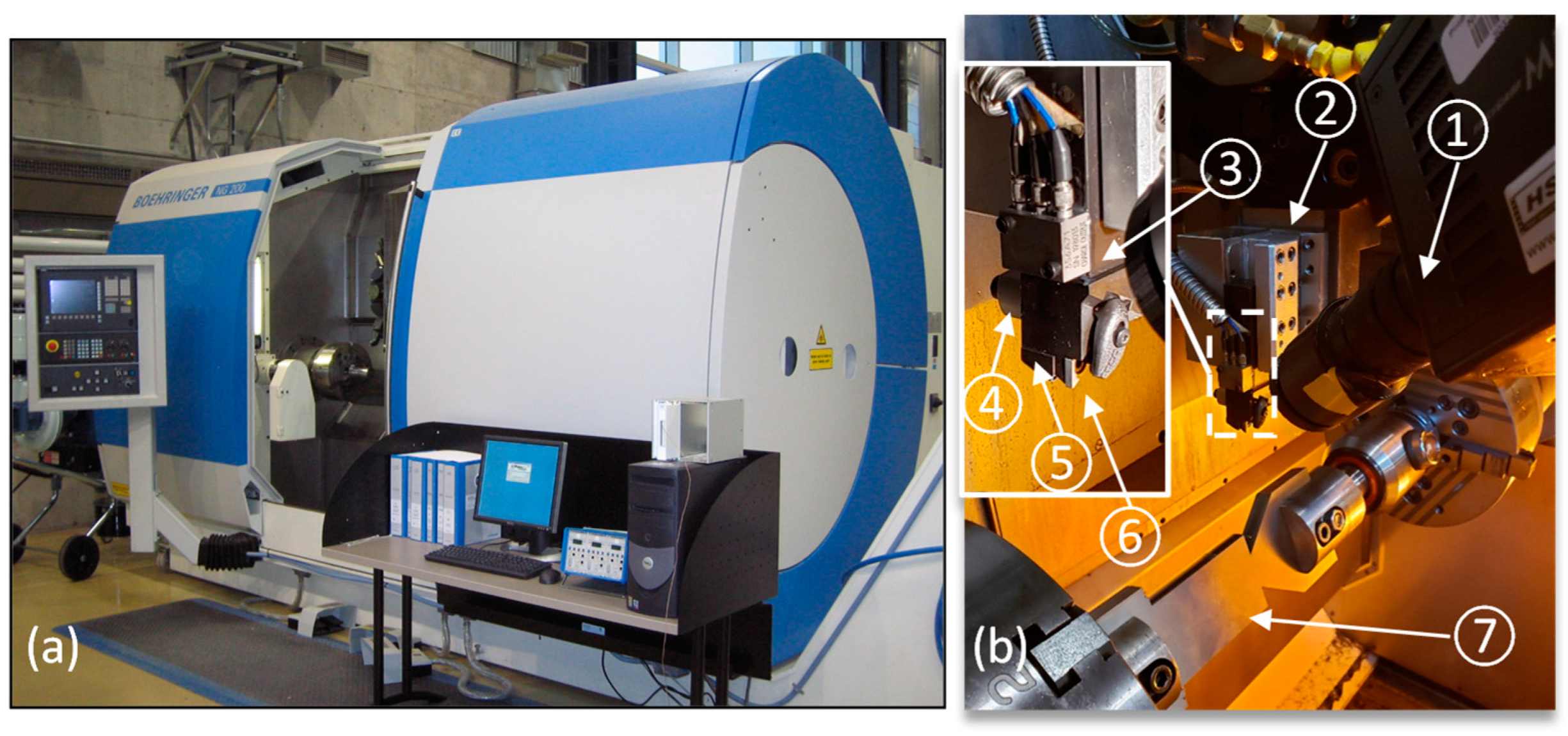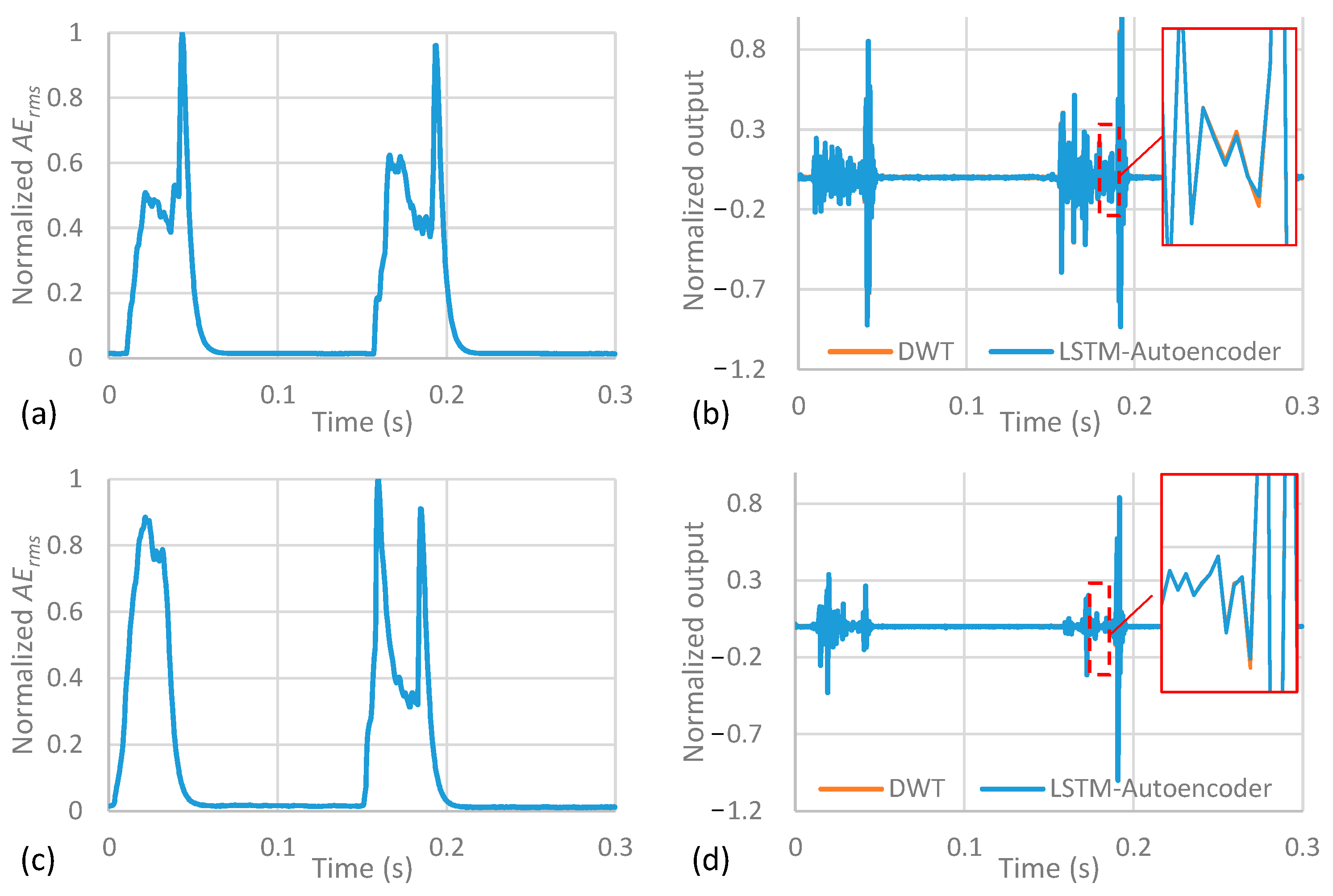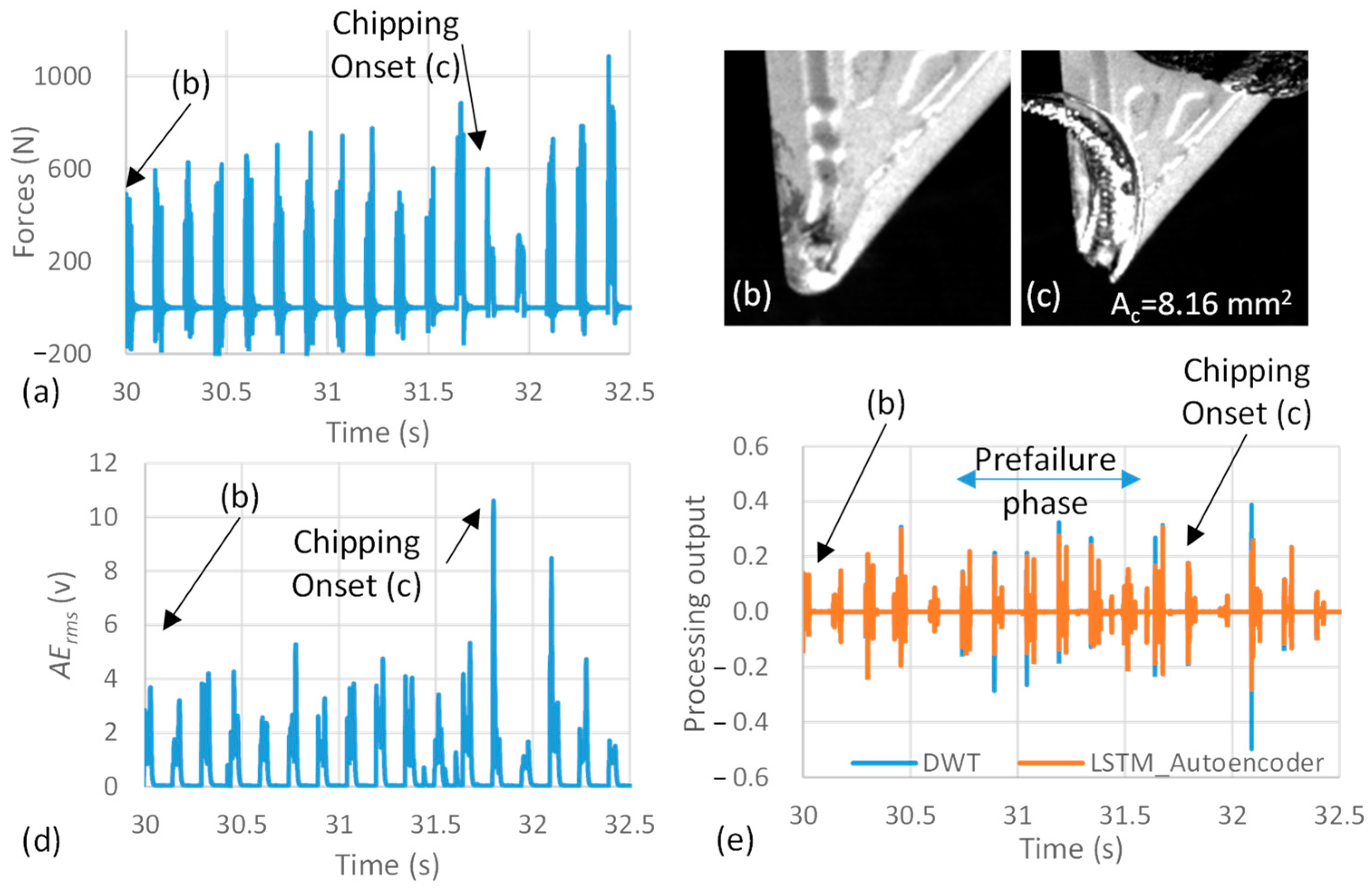A Real-Time Deep Machine Learning Approach for Sudden Tool Failure Prediction and Prevention in Machining Processes
Abstract
:1. Introduction
2. Acoustic Emissions in Intermittent Cutting Operations
3. Anomaly Detection Approach for Sudden Tool Failure Prediction
3.1. Discrete Wavelet Transform
3.2. LSTM Autoencoder Neural Network
3.3. DWT-LSTM Implementation
4. Experimental Setup and Test Matrix
5. Results and Discussion
5.1. DWT-LSTM Processing Approach Capabilities
5.2. Online Implementation and Benchmarking of the DWT-LSTM Autoencoder
6. Conclusions
Author Contributions
Funding
Institutional Review Board Statement
Informed Consent Statement
Data Availability Statement
Acknowledgments
Conflicts of Interest
References
- Ma, J.; Luo, D.; Liao, X.; Zhang, Z.; Huang, Y.; Lu, J. Tool wear mechanism and prediction in milling TC18 titanium alloy using deep learning. Measurement 2021, 173, 108554. [Google Scholar] [CrossRef]
- Mohamed, A.; Hassan, M.; M’Saoubi, R.; Attia, H. Tool Condition Monitoring for High-Performance Machining Systems—A Review. Sensors 2022, 22, 2206. [Google Scholar] [CrossRef] [PubMed]
- Groover, P. Fundamentals of Modern Manufacturing: Materials, Processes, and Systems; Prentice Hall: Upper Saddle River, NJ, USA, 1996. [Google Scholar]
- Kuttolamadom, M.A. Prediction of the Wear and Evolution of Cutting Tools in a Carbide/Ti-6Al-4V Machining Tribosystem by Volumetric Tool Wear Characterization and Modeling. Ph.D. Thesis, Clemson University, Clemson, SC, USA, 2012. [Google Scholar]
- Marinescu, I.; Axinte, D.A. A critical analysis of effectiveness of acoustic emission signals to detect tool and workpiece malfunctions in milling operations. Int. J. Mach. Tools Manuf. 2008, 48, 1148–1160. [Google Scholar] [CrossRef]
- Tlusty, J.; Andrews, G.C. A Critical Review of Sensors for Unmanned Machining. CIRP Ann. 1983, 32, 563–572. [Google Scholar] [CrossRef]
- Haber, R.E.; Jiménez, J.E.; Peres, C.R.; Alique, J.R. An investigation of tool-wear monitoring in a high-speed machining process. Sens. Actuators A Phys. 2004, 116, 539–545. [Google Scholar] [CrossRef]
- Vallejo, A.J.; Morales-Menendez, R. Cost-effective supervisory control system in peripheral milling using HSM. Annu. Rev. Control. Annu. Rev. Control. 2010, 34, 155–162. [Google Scholar] [CrossRef]
- Vallejo, A.J.; Morales-Menéndez, R.; Alique, J. On-line cutting tool condition monitoring in machining processes using artificial intelligence. Robot. Autom. Control. 2008, 1, 143–166. [Google Scholar] [CrossRef]
- Dornfeld, D.; Lee, D.-E. Machine Design for Precision Manufacturing; Springer: Berlin/Heidelberg, Germany, 2008. [Google Scholar]
- Kannatey-Asibu, E.; Dornfeld, D.A. Quantitative relationships for acoustic emission from orthogonal metal cutting. J. Manuf. Sci. Eng. 1981, 103, 330–340. [Google Scholar] [CrossRef]
- Cao, H.; Chen, X.; Zi, Y.; Ding, F.; Chen, H.; Tan, J.; He, Z. End milling tool breakage detection using lifting scheme and Mahalanobis distance. Int. J. Mach. Tools Manuf. 2008, 48, 141–151. [Google Scholar] [CrossRef]
- Hassan, M.; Sadek, A.; Damir, A.; Attia, M.; Thomson, V. Tool Pre-Failure Monitoring in Intermittent Cutting Operations. In Proceedings of the ASME 2016 International Mechanical Engineering Congress and Exposition, Phoenix, AZ, USA, 11–17 November 2016; p. V002T002A049. [Google Scholar]
- Teti, R.; Mourtzis, D.; D’Addona, D.M.; Caggiano, A. Process monitoring of machining. CIRP Ann. 2022, 71, 529–552. [Google Scholar] [CrossRef]
- Serin, G.; Sener, B.; Ozbayoglu, A.M.; Unver, H.O. Review of tool condition monitoring in machining and opportunities for deep learning. Int. J. Adv. Manuf. Technol. 2020, 109, 953–974. [Google Scholar] [CrossRef]
- Hase, A.; Wada, M.; Koga, T.; Mishina, H. The relationship between acoustic emission signals and cutting phenomena in turning process. Int. J. Adv. Manuf. Technol. 2014, 70, 947–955. [Google Scholar] [CrossRef]
- Hassan, M.; Sadek, A.; Damir, A.; Attia, M.H.; Thomson, V. A novel approach for real-time prediction and prevention of tool chipping in intermittent turning machining. CIRP Ann. 2018, 67, 41–44. [Google Scholar] [CrossRef]
- Hassan, M.; Sadek, A.; Attia, H.; Thomson, V. Real-time Tool Prefailure Detection in Conventional and High-Speed Milling Applications. Procedia CIRP 2022, accepted. [Google Scholar]
- Erhan, L.; Ndubuaku, M.; Di Mauro, M.; Song, W.; Chen, M.; Fortino, G.; Bagdasar, O.; Liotta, A. Smart anomaly detection in sensor systems: A multi-perspective review. Inf. Fusion 2021, 67, 64–79. [Google Scholar] [CrossRef]
- Nassif, A.B.; Talib, M.A.; Nasir, Q.; Dakalbab, F.M. Machine Learning for Anomaly Detection: A Systematic Review. IEEE Access 2021, 9, 78658–78700. [Google Scholar] [CrossRef]
- Pang, G.; Shen, C.; Cao, L.; Hengel, A.V.D. Deep Learning for Anomaly Detection: A Review. ACM Comput. Surv. 2021, 54, 38. [Google Scholar] [CrossRef]
- Luo, T.; Nagarajan, S.G. Distributed anomaly detection using autoencoder neural networks in WSN for IoT. In Proceedings of the 2018 IEEE International Conference on Communications (ICC), Kansas City, MO, USA, 20–24 May 2018; pp. 1–6. [Google Scholar]
- Chen, C.-Y.; Chang, S.-C.; Hsieh, Y.-C.; Hsu, H.-T.; Liao, D.-Y.; Luh, P.B. Effective Detection of Prominent Anomalies from Semiconductor Equipment Sensory Data by Using Unsupervised Learning. In Proceedings of the 18th International Conference on Automation Technology (Automation 2021), Seoul, Republic of Korea, 5–7 March 2021. [Google Scholar]
- Ding, A.; Qin, Y.; Wang, B.; Jia, L.; Cheng, X. Lightweight Multi-Scale Convolutional Networks with Adaptive Pruning for Intelligent Fault Diagnosis of Train Bogie Bearings in Edge Computing Scenarios. IEEE Trans. Instrum. Meas. 2022, 72, 3502813. [Google Scholar]
- Diei, E.N.; Dornfeld, D.A. A Model of Tool Fracture Generated Acoustic Emission During Machining. J. Eng. Ind. 1987, 109, 227–233. [Google Scholar] [CrossRef]
- Daubechies, I.; Sweldens, W. Factoring wavelet transforms into lifting steps. J. Fourier Anal. Appl. 1998, 4, 245–267. [Google Scholar] [CrossRef]
- Wang, Z.; Balog, R.S. Arc fault and flash signal analysis in DC distribution systems using wavelet transformation. IEEE Trans. Smart Grid 2015, 6, 1955–1963. [Google Scholar] [CrossRef]
- Sun, C.; Ma, M.; Zhao, Z.; Tian, S.; Yan, R.; Chen, X. Deep transfer learning based on sparse autoencoder for remaining useful life prediction of tool in manufacturing. IEEE Trans. Ind. Inform. 2018, 15, 2416–2425. [Google Scholar] [CrossRef]
- Dou, J.; Xu, C.; Jiao, S.; Li, B.; Zhang, J.; Xu, X. An unsupervised online monitoring method for tool wear using a sparse auto-encoder. Int. J. Adv. Manuf. Technol. 2020, 106, 2493–2507. [Google Scholar] [CrossRef]
- He, Z.; Shi, T.; Xuan, J. Milling tool wear prediction using multi-sensor feature fusion based on stacked sparse autoencoders. Measurement 2022, 190, 110719. [Google Scholar] [CrossRef]
- González-Muñiz, A.; Díaz, I.; Cuadrado, A.A.; García-Pérez, D. Health indicator for machine condition monitoring built in the latent space of a deep autoencoder. Reliab. Eng. Syst. Saf. 2022, 224, 108482. [Google Scholar] [CrossRef]
- Ou, J.; Li, H.; Huang, G.; Zhou, Q. A Novel Order Analysis and Stacked Sparse Auto-Encoder Feature Learning Method for Milling Tool Wear Condition Monitoring. Sensors 2020, 20, 2878. [Google Scholar] [CrossRef] [PubMed]
- Hassan, M.; Sadek, A.; Attia, M.H. A Generalized Multisensor Real-Time Tool Condition–Monitoring Approach Using Deep Recurrent Neural Network. Smart Sustain. Manuf. Syst. 2019, 3, 12. [Google Scholar] [CrossRef]
- Hochreiter, S.; Schmidhuber, J. Long short-term memory. Neural Comput. 1997, 9, 1735–1780. [Google Scholar] [CrossRef]
- Graves, A.; Mohamed, A.-R.; Hinton, G. Speech recognition with deep recurrent neural networks. In Proceedings of the 2013 IEEE International Conference on Acoustics, Speech and Signal Processing, Vancouver, BC, Canada, 26–31 May 2013; pp. 6645–6649. [Google Scholar]





| Role | Test Number | Speed (m/min) | Feed (mm/min) | Depth of Cut (mm) |
|---|---|---|---|---|
| Training | 1 | 35–45 | 50–90 | 1 |
| Validation | 2 | 45 | 80 | 1 |
| Validation | 3 | 35 | 100 | 1.25 |
| Validation | 4 | 75 | 95 | 1.5 |
| Prefailure Detection Window (ms) | Processing Time (ms) | |||
|---|---|---|---|---|
| Test Number | DWT-LSTM | TKEO-HHT | DWT-LSTM | TKEO-HHT |
| 2 | 830 | 600 | 1.3 | 1–3.8 |
| 3 | 660 | 970 | 1.1 | 1.3–4 |
| 4 | 540 | 850 | 1.4 | 1.4–3.4 |
Disclaimer/Publisher’s Note: The statements, opinions and data contained in all publications are solely those of the individual author(s) and contributor(s) and not of MDPI and/or the editor(s). MDPI and/or the editor(s) disclaim responsibility for any injury to people or property resulting from any ideas, methods, instructions or products referred to in the content. |
© 2023 by the authors. Licensee MDPI, Basel, Switzerland. This article is an open access article distributed under the terms and conditions of the Creative Commons Attribution (CC BY) license (https://creativecommons.org/licenses/by/4.0/).
Share and Cite
Hassan, M.; Sadek, A.; Attia, H. A Real-Time Deep Machine Learning Approach for Sudden Tool Failure Prediction and Prevention in Machining Processes. Sensors 2023, 23, 3894. https://doi.org/10.3390/s23083894
Hassan M, Sadek A, Attia H. A Real-Time Deep Machine Learning Approach for Sudden Tool Failure Prediction and Prevention in Machining Processes. Sensors. 2023; 23(8):3894. https://doi.org/10.3390/s23083894
Chicago/Turabian StyleHassan, Mahmoud, Ahmad Sadek, and Helmi Attia. 2023. "A Real-Time Deep Machine Learning Approach for Sudden Tool Failure Prediction and Prevention in Machining Processes" Sensors 23, no. 8: 3894. https://doi.org/10.3390/s23083894
APA StyleHassan, M., Sadek, A., & Attia, H. (2023). A Real-Time Deep Machine Learning Approach for Sudden Tool Failure Prediction and Prevention in Machining Processes. Sensors, 23(8), 3894. https://doi.org/10.3390/s23083894






